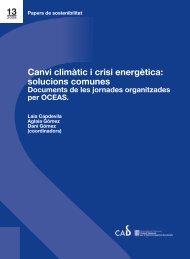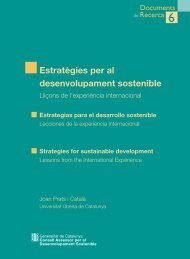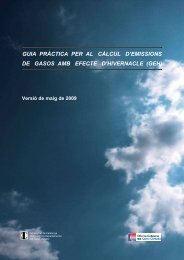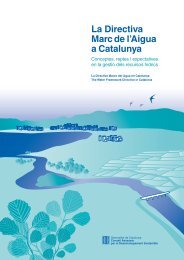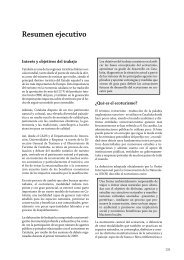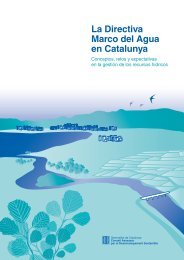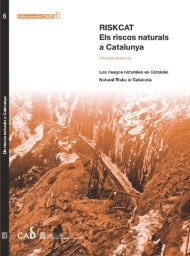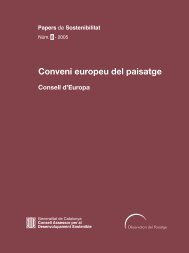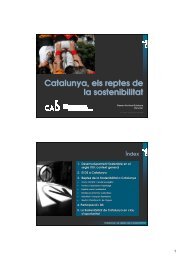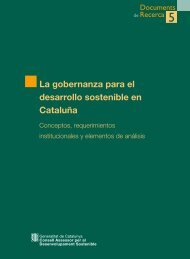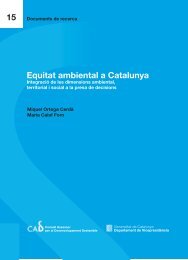- Page 1:
Documents de Recerca 10 Evaluación
- Page 4 and 5:
BIBLIOTECA DE CATALUNYA. DATOS CIP:
- Page 7:
Evaluación del Impacto Regulatorio
- Page 10 and 11:
2.3.1. Holanda: Flexibilidad y cons
- Page 13 and 14:
Presentación Los instrumentos regu
- Page 15 and 16:
Glosario de herramientas de evaluac
- Page 17 and 18:
1. Introducción a la Evaluación d
- Page 19 and 20:
Los objetivos de la EIR son múltip
- Page 21 and 22:
Según la OCDE (1995), estas pregun
- Page 23 and 24:
c) Formación de los reguladores. F
- Page 25 and 26:
impacta negativamente sobre la sost
- Page 27 and 28:
nivel de participación -centrada e
- Page 29 and 30:
influir en desarrollos normativos m
- Page 31 and 32:
(la ampliación del campo ambiental
- Page 33 and 34:
consecuencias ambientales de propue
- Page 35 and 36:
Unión Europea al marco legal de la
- Page 37 and 38:
manera coherente. Con todo, de lo q
- Page 39 and 40:
2. La práctica internacional relat
- Page 41 and 42:
2.2. Metodología 2.2.1. Selección
- Page 43 and 44:
2.2.2.1. Contextualización de la i
- Page 45 and 46:
2.2.2.4. Balance global El último
- Page 47 and 48:
2.3. Análisis descriptivo 2.3.1. H
- Page 49 and 50:
La metodología de aplicación actu
- Page 51 and 52:
Sección 4: Consideraciones Una vez
- Page 53 and 54:
La guía para el uso del test indic
- Page 55 and 56:
Ítems del Test de Impacto Ambienta
- Page 57 and 58:
1997 (22%, 46% y 20% respectivament
- Page 59 and 60:
tendencia decreciente continúe en
- Page 61 and 62:
calidad general del proceso, y cont
- Page 63 and 64:
es obligatoria, no existen estánda
- Page 65 and 66:
Tercer filtro: Fase 1, Escaneo Ráp
- Page 67 and 68:
2.3.2. Reino Unido: Capacidad de ap
- Page 69 and 70:
al final de la EIR Parcial se inclu
- Page 71 and 72:
Identificación de opciones múltip
- Page 73 and 74:
Tabla 5a. Costes para los afectados
- Page 75 and 76:
Protecting Vulnerable People (publi
- Page 77 and 78:
Test de Impacto sobre la pequeña e
- Page 79 and 80:
EIR Final relativa a la Landfill Al
- Page 81 and 82:
Un primer nivel de asesoramiento pa
- Page 83 and 84:
En el proceso britànico se hacen p
- Page 85 and 86:
2.3.2.4. Balance global Puntos fuer
- Page 87 and 88:
puertos), justicia y asuntos intern
- Page 89 and 90:
2.3.3.3. Diseño organizativo Estru
- Page 91 and 92:
Grado de apertura del proceso Los p
- Page 93 and 94:
La primera fase de experimentación
- Page 95 and 96:
Los pasos a seguir se sintetizan en
- Page 97 and 98:
El grado de interacción entre los
- Page 99 and 100:
Resulta difícil desarrollar e impl
- Page 101 and 102:
Gráfico 5. Plan de consulta region
- Page 103 and 104:
Definición de las necesidades Cada
- Page 105 and 106:
económicos y sociales relacionados
- Page 107 and 108:
garantiza una introducción gradual
- Page 109 and 110:
El grado de interacción entre los
- Page 111 and 112:
La falta de un servicio de bases de
- Page 113 and 114:
En los países en los que la introd
- Page 115 and 116:
derar intermedia a nivel central it
- Page 117 and 118:
generadas exógenamente a los proce
- Page 119 and 120:
3. Propuesta de aplicación de la E
- Page 121 and 122:
Dentro del sistema de fuentes del d
- Page 123 and 124:
procedimiento será, pues, el objet
- Page 125 and 126:
d) Publicación - Diario Oficial de
- Page 127 and 128:
en cuenta que hace menos de un año
- Page 129 and 130:
ii) Informe de los servicios juríd
- Page 131 and 132:
c) Aprobación La potestad reglamen
- Page 133 and 134:
La estructura de la norma Uno de lo
- Page 135 and 136:
la reforma y realizar un seguimient
- Page 137 and 138:
En particular, el criterio 3.1 hace
- Page 139 and 140:
3. Beneficios 3.1. ¿A quién benef
- Page 141 and 142:
uena administración perseguida”
- Page 143 and 144:
Es bien sabido que el gobierno de C
- Page 145 and 146:
5. Seguimiento y evaluación Identi
- Page 147 and 148:
a nivel europeo y las implicaciones
- Page 149 and 150:
ilustrativo, en este sentido, el ca
- Page 151 and 152:
que provienen de la auto-regulació
- Page 153 and 154:
Muchas veces, en el proceso de defi
- Page 155 and 156:
impactos en sentido amplio. Por una
- Page 157 and 158:
de la Red Natura 2000 que aumenta d
- Page 159 and 160:
Uso de energía y movilidad Cambio
- Page 161 and 162:
Impactos sociales Ámbito temático
- Page 163 and 164:
Fortaleza de los sectores empresari
- Page 165 and 166:
3.2.1.5. Seguimiento y evaluación
- Page 167 and 168:
No es preciso decir que se puede es
- Page 169 and 170:
actores en torno a la metodología
- Page 171 and 172:
Todo ello nos permite retornar al p
- Page 173 and 174:
Anexos Anexo 1 RELACIÓN DE ENTREVI
- Page 175 and 176:
Anexo 2 Interviews: THE NETHERLANDS
- Page 177 and 178:
ACTAL • When was ACTAL establishe
- Page 179 and 180:
Methodology • Scope of applicatio
- Page 181 and 182:
FIRENZE - REGIONE TOSCANA, 5 Settem
- Page 183 and 184:
Interviu: EUROPEAN COMISSION • Wh
- Page 185 and 186:
de impacto tuviesen lugar a nivel d
- Page 187 and 188:
Los beneficios se presentan de form
- Page 189 and 190:
Bibliografia APOGEE RESEARCH (1997)
- Page 191 and 192:
ENPLAN (2004). ENPLAN. Project: Env
- Page 193 and 194:
estudio y creación de la Agencia E
- Page 195:
SANTAMARIA PASTOR, J. A. “La admi
- Page 199:
Índex Presentació................
- Page 202 and 203:
200 El primer capítol d’aquest t
- Page 204 and 205:
-reforma regulatòria- partia de la
- Page 206 and 207:
assenyala que, tot i que existeixen
- Page 208 and 209:
h) Implicació del públic de forma
- Page 210 and 211:
Passos de la nova avaluació d’im
- Page 212 and 213:
Així, d’una banda, els objectes
- Page 214 and 215:
Aquests primers esborranys han perm
- Page 216 and 217:
que té en compte impactes econòmi
- Page 218 and 219: 2.3.2. Lliçons apreses A partir de
- Page 220 and 221: i) Obertura del procés regulatori
- Page 222 and 223: ) Introducció de la necessitat d
- Page 224 and 225: augmentant la capacitat de l’Admi
- Page 226 and 227: l’aplicació a lleis, decrets leg
- Page 228 and 229: Com es pot deduir de la taula de co
- Page 231: Evaluación del Impacto Regulatorio
- Page 235 and 236: Presentación Los instrumentos regu
- Page 237 and 238: 1. Introducción a la evaluación d
- Page 239 and 240: Objetivos principales de la EIR (Ja
- Page 241 and 242: ) Asignación clara y detallada de
- Page 243 and 244: los gobiernos para llevar a cabo su
- Page 245 and 246: 2. La práctica internacional relat
- Page 247 and 248: Diseño organizativo Diseño del pr
- Page 249 and 250: Vemos que la maximización del comp
- Page 251 and 252: La ubicación de la unidad de coord
- Page 253 and 254: preliminar - evaluación profundiza
- Page 255 and 256: 3. Propuesta de la aplicación de l
- Page 257 and 258: 3.1.2. Particularidades de interés
- Page 259 and 260: de impacto de género, se podría i
- Page 261 and 262: 2. Identificación de objetivos pol
- Page 263 and 264: Inicialmente, es preciso poner de r
- Page 265: Regulatory Impact Assessment: Inter
- Page 270 and 271: and its process. This tool is also
- Page 272 and 273: development of a regulatory policy
- Page 274 and 275: differences between national models
- Page 276 and 277: in the initial phases of policy dev
- Page 278 and 279: Steps of the new impact assessment
- Page 280 and 281: Thus, on one hand, the subjects of
- Page 282 and 283: These first drafts made it possible
- Page 284 and 285: The criteria used in the assessment
- Page 286 and 287: that all the available RIAs can be
- Page 288 and 289: ecommendations of the OECD (2002) f
- Page 290 and 291: ) Introduction of the need to draw
- Page 292 and 293: and administrative simplification p
- Page 294 and 295: a considerable impact on the enviro
- Page 296 and 297: As can be deduced from the table of
- Page 299 and 300: Publicaciones del Consejo Asesor pa
- Page 301 and 302: Núm. 6. PRATS i CATALÀ, Joan. Est
- Page 303: Coediciones • Informe Planeta Viu




